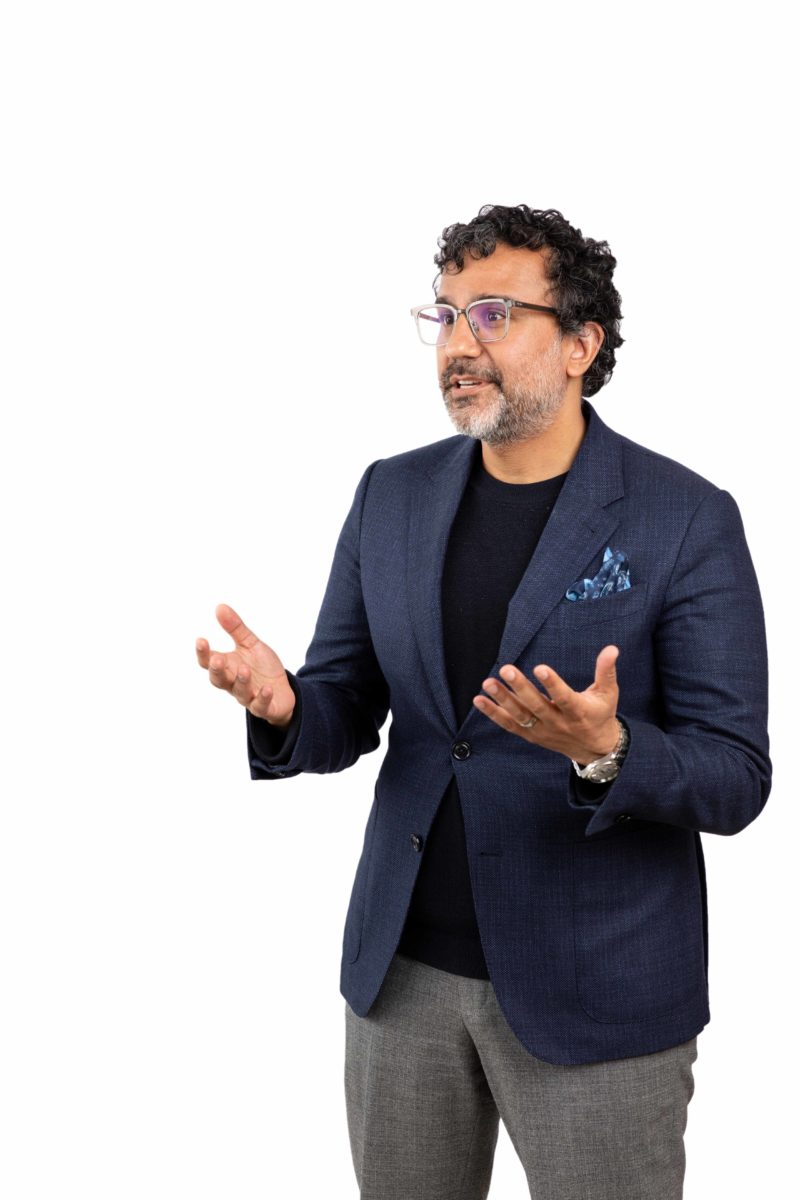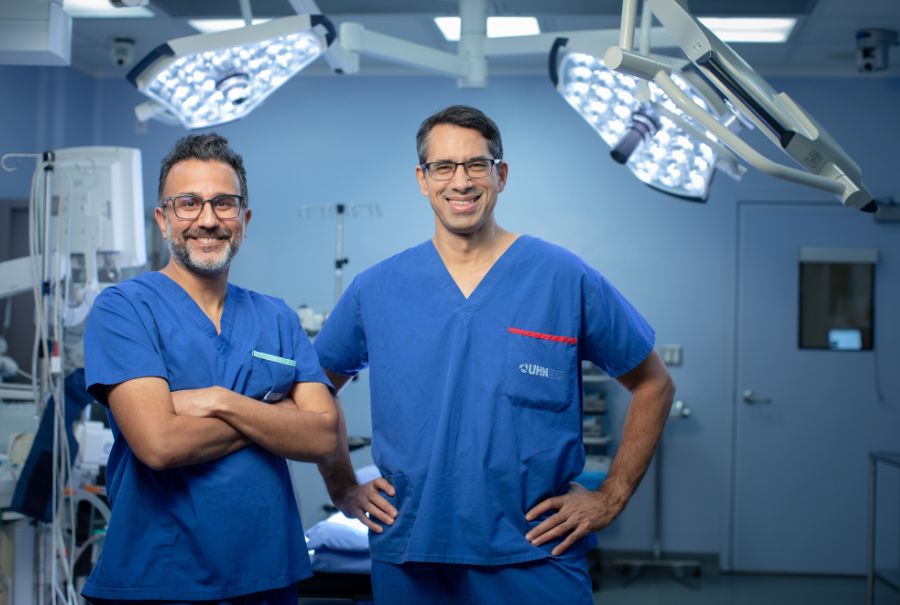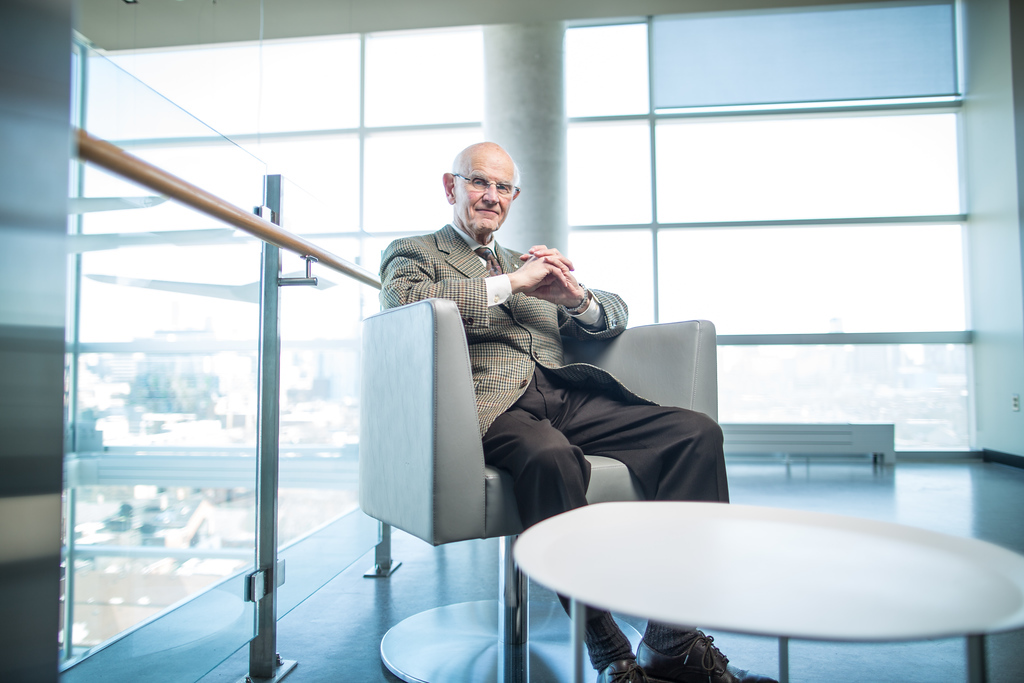Colin Croxon (centre) has struggled with seizures for nearly a decade. Thanks to deep brain stimulation technology and an expert team at the Krembil Brain Institute, he can now enjoy life again. (Photo: Kirsten McGoey)
By Diane Peters
Kim Croxon has had many difficult days over the years, but one stands out. While at her job coaching gymnastics, she got a panicked call from her daughters, who told her to come home right away. She sped down the highway but could barely reach her house, as several ambulances, fire trucks and police cars were blocking her street. They were there to help her then-teenaged son, Colin, who’d had a severe seizure. He’d fallen down the stairs and had no vital signs until, thankfully, the paramedics revived him.
Now 22, Colin was perfectly healthy until the age of 13, when he started developing seizures. He was diagnosed with epilepsy, and the whole family has been affected by his seizures – he’s had up to 22 a day – resulting in regular calls to 911 and trips to the nearby hospital in Bowmanville, Ont. “All of us in this house have severe PTSD. We hear something drop, and we all run,” says Croxon.
To deal with Colin’s debilitating epilepsy, the Croxon family went to the Krembil Brain Institute (KBI), where they met with a multidisciplinary team of leading epilepsy experts, who determined that a vagus nerve stimulation device may be the best option for Colin. The device, which delivers electrical impulses to the vagus nerve, located in the neck, and can reduce seizures, was surgically implanted in 2017 by Dr. Taufik Valiante.
While that helped for a while, the seizures eventually restarted and the epilepsy team suggested deep brain stimulation (DBS). In November 2020, Dr. Suneil Kalia placed electrodes from a DBS device into Colin’s brain, and a controller device was put in his chest.
The result of the surgery was “mind-blowing,” says Croxon. Colin’s seizures reduced in frequency by 90 per cent. After five weeks, he was able to taper off and then stop taking one of his strongest epilepsy medications. He now wants to train to become a mechanic. “I want to go out and finally enjoy the world,” he often says to his family.
That’s the potential impact of neuromodulation, a technology that uses electrical stimulation to alter circuit activity and reduce seizures in the brain. The KBI is already a global leader in this area, with teams working hard to push this approach to treating nerve-related conditions – especially brain conditions. “The whole field of neuromodulation is exploding,” says Dr. Valiante, Director of the Surgical Epilepsy Program at the KBI, who is also part of the Sprott Department of Surgery at University Health Network (UHN) and Co-Director of the CenteR for Advancing Neurotechnological Innovation to Application (CRANIA), which seeks to develop new neuromodulation technologies.

Stimulating nerves
“The entire body is basically run by nerves, and neuromodulation is anything that alters cell and circuit activity through a device,” explains Dr. Valiante. Often, that entails using electrodes, sometimes surgically implanted, or working from the surface of the skin to deliver an electrical impulse.
With modulation, electricity either wakes up a nerve or stops it from doing something. “When you add stimulation or electricity, especially to the brain, you either enhance electrical circuits or you short-circuit them,” explains Dr. Lorraine Kalia, a neurologist and senior scientist in the Edmond J. Safra Program in Parkinson’s Disease and the Morton and Gloria Shulman Movement Disorders Clinic at the KBI.
“We want to look at neuromodulation as a whole. This is something that will be unique worldwide. We are trying to change the field.”
– Dr. Alfonso Fasano
DBS is one of the oldest and most widely used forms of neuromodulation, pioneered in part by work done by KBI neurosurgeon Dr. Andres Lozano, but there’s also peripheral nerve stimulation, applied to areas such as the vagus nerve, plus the use of stimulation along the spinal cord. Clinicians target abnormal brain circuits, spinal cord and peripheral nerves, often with electrodes, to reduce the tremors and stiffness of Parkinson’s disease and to help other movement disorders, mood disorders, pain, spinal cord dysfunction and urological conditions.
Neuromodulation can have life-changing impacts on a range of diseases, often alleviating symptoms and allowing patients to reduce their medications. As well, Dr. Valiante says children with epilepsy are often more alert and engaged, a benefit of reduced medications but also a possible positive side effect of neuromodulation therapy. “There’s been arguments that brain stimulation may have some pro-cognitive effects,” he says.
Currently, half of all DBS implants in Canada are performed at the KBI, but that represents just one aspect of its wide-ranging neuromodulation work. Its clinicians and researchers are reimagining the field to offer more effective treatments and invent game-changing devices – all of which are helping doctors treat nerve-related health conditions and symptoms.
A multidisciplinary team
One way the KBI is leading the charge is by creating multidisciplinary teams that work together to study and improve upon neuromodulation techniques, says Dr. Valiante.
Typically, different experts perform neuromodulation on different parts of the body. They often work separately and seldom interact. Dr. Alfonso Fasano, a neurologist and clinician investigator at the KBI and Chair in Neuromodulation and Multidisciplinary Care, is creating an interdisciplinary neuromodulation unit at the KBI. The unit will allow experts such as neurologists, pain specialists and urologists to share innovations, try new approaches to treatment and offer comprehensive training. “We want to look at neuromodulation as a whole,” he says. “This is something that will be unique worldwide. We are trying to change the field.”
Dr. Fasano believes this new unit will help care teams across the KBI better understand neuromodulation and – importantly – stop people from thinking of it as a last-resort treatment. “It’s been proven that if you do a treatment like DBS earlier, it’s better for the patient’s quality of life,” says Dr. Fasano. “They don’t lose their job. They keep their friends. If you wait too long, you treat patients whose conditions are too advanced, and then surgery becomes too risky.”
Making smarter devices
A few months after Colin got his DBS device, several days of stormy winter weather triggered seizures. Fortunately, Colin’s revolutionary device records brain activity data and sends it to a dedicated cellphone in his home. His team at the KBI then downloads the data and compares it to his seizure activity, using it to create a customized setting to better manage his condition.
This kind of monitoring is incredibly innovative – it wasn’t long ago that brainwave monitoring could only happen during brain surgery. Now, clinicians can peer into the inner workings of the organ anywhere and at any time. And the technology is only getting more sophisticated. Devices are now starting to sense when a seizure is about to happen, while future tech could stop seizures before they occur. “The next generation of devices will have the capacity to sense what the brain state is and respond,” adds Dr. Suneil Kalia, a neurosurgeon and scientist at the KBI and part of the Sprott Department of Surgery at UHN.

“We’re going all the way from the basic science to developing the devices and then implanting the devices. We’re building an ecosystem here to do it all.”
– Dr. Taufik Valiante
The KBI researchers are a big part of this promising future. Dr. Valiante has a smart device in the prototype phase called a neural interface processor for brain-state classification and programmable-waveform neurostimulation (NURIP). It uses an implantable computer chip that can detect an impending seizure and deliver stimulation to stop it from occurring. The system uses artificial intelligence to learn when and where in the brain a patient has seizures, and uses stimulation to shut them down before they happen.
Inventing more devices like NURIP is a key goal at the KBI. “We’ve been leaders in using commercial devices. We’re now motivated to create that next generation of devices,” says Dr. Valiante.
He helped launch CRANIA in 2017 for this reason. It’s a partnership between the KBI, Toronto Rehab at UHN and several faculties at the University of Toronto. Dr. Valiante says having top equipment and expertise from across UHN will help Toronto become a leader in creating the next generation of neuromodulation devices, software and spinoff companies.

Preventing disease
Drs. Lorraine and Suneil Kalia, a husband and wife team, are also looking at how neuromodulation might be used to prevent diseases from progressing in the first place. The Kalias are developing drugs to stop cell death in Parkinson’s, and neuromodulation may be able to do this, too. “In stimulating brain circuits, we might be able to affect molecular pathways in the brain cells of patients with Parkinson’s to prevent those cells from dying,” says Dr. Lorraine Kalia.

While this research is still very preliminary, she explains, “if we could use stimulation for prevention, that would be an even stronger indicator for us to think about using stimulation earlier.”
By treating patients with neuromodulation for a wide range of conditions, inventing the next generation of smarter and more responsive devices, and undertaking basic research to actually prevent illness, the KBI has entrenched itself as a world leader in this growing field.
“We’re going all the way from the basic science to developing the devices and then implanting the devices,” says Dr. Valiante. “We’re building an ecosystem here to do it all.”
This article originally appeared in the Krembil Brain Institute magazine.


